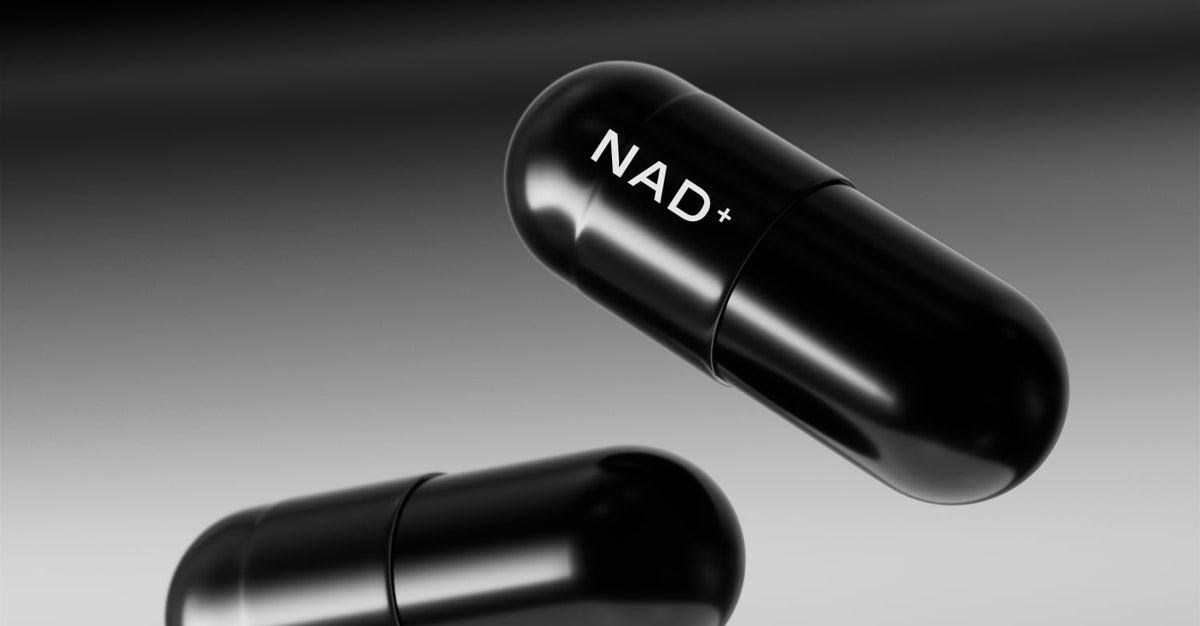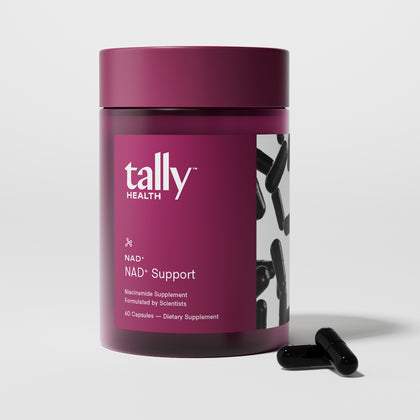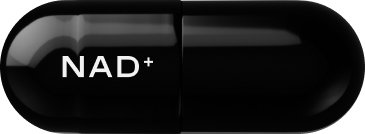

NAD⁺ supplements have gone from obscure to omnipresent, popping up in wellness routines, IV clinics, and supplement stacks everywhere. NAD⁺ is essential for cell metabolism and energy production in every living cell. Living cells are the fundamental biological units that utilize NAD⁺ for essential functions like metabolism, DNA repair, and cellular signaling. As more people look to support energy, metabolism, and healthy aging at the cellular level, interest in NAD⁺ precursors like niacinamide has grown steadily. The benefits of NAD⁺ for overall wellness and well-being include supporting energy, metabolism, and healthy aging and can be found in Tally Health’s NAD+ supplement.
But with the rise in popularity comes a wave of new delivery methods, each promising better results. NAD⁺ supports cellular energy and is vital for the function of human cells. Supplementing with NAD⁺ may provide an energy boost, helping to fuel cellular metabolisms and improve stamina, especially for those experiencing fatigue or low energy. Capsules, sublingual powders, IV infusions, even patches — which one actually works best? Let’s unpack the science behind how your body absorbs NAD⁺ and what method may offer the most benefit.

What’s the Best Way to Take NAD+? NAD Injections, capsules, IVs, patches
NAD + is crucial for key cellular functions and supports multiple metabolic pathways in the body. Different delivery methods of NAD + supplementation may influence its therapeutic benefits, including its potential to treat metabolic diseases, aging, and related health conditions. One molecule, multiple methods: Let’s break down NAD⁺ delivery:
Our Recommendation: Oral supplementation

Oral supplementation is the most common approach to supporting NAD⁺ levels. However, direct oral supplementation of NAD⁺ is not highly bioavailable due to its large size and positive charge, which is why most supplementation is made with an NAD⁺ precursor like niacinamide (found in our NAD⁺ booster) [1]. Vitamin precursors such as nicotinic acid are essential for NAD⁺ biosynthesis, as they serve as key molecules in pathways like the Preiss–Handler pathway that convert these precursors into NAD⁺. Other vitamin B3 forms, such as nicotinamide mononucleotide and nicotinamide riboside, are also used as NAD⁺ precursors.
While bioavailability can vary based on the specific compound and individual physiology, oral forms (including with niacinamide) have been shown to boost circulating NAD⁺ levels in humans [2, 3]. Another study demonstrated that a single dose of niacinamide effectively elevated NAD⁺ concentrations in healthy subjects [4]. Furthermore, of all the NAD⁺ precursors available, most data have been collected on supplements containing niacin (also known as nicotinic acid) or niacinamide (also known as nicotinamide) [5]. There are significant differences in absorption and efficacy between various vitamin B3 precursors, including nicotinamide mononucleotide, nicotinamide riboside, and nicotinic acid.
Dietary supplements containing these NAD⁺ precursors are commonly used to support metabolic processes, such as NAD+ by Tally Health.
Sublingual administration

Sublingual delivery involves placing the NAD⁺ supplement under the tongue. By absorbing through the mucous membranes, it potentially bypasses the digestive system and may enhance bioavailability. While studies are quite limited, new research suggests that sublingual NAD⁺ can boost NAD + levels [6]. There was a 2-fold increase in plasma NAD⁺ levels after just 10 minutes of dosing. Sublingual delivery has also been shown to increase NAD + availability in mammalian cells, supporting cellular metabolism. The findings also suggest a bioavailability of sublingual NAD⁺ at 22% compared to IV administration.
Intravenous (IV) NAD⁺ therapy

IV administration delivers NAD⁺ directly into the bloodstream for rapid availability. While understudied, clinical studies have been published that have evaluated the efficacy of IV NAD⁺ therapy.
In one study, repeated NAD⁺ infusions over six days significantly increased the blood NAD⁺ metabolome (which includes NAD⁺ and its related metabolites) in elderly adults aged 70–80 [7]. However, another study found that a single IV NAD⁺ infusion did not significantly raise whole blood NAD⁺ levels within 24 hours [8]. Although NAD⁺ levels trended upward at seven and 14 days post-infusion, the increases were not statistically significant compared to baseline or other treatment groups. Some clinical trials also assess metabolic health markers such as blood pressure and cardiovascular disease risk when evaluating the outcomes of NAD⁺ interventions. IV NAD⁺ therapy is also being explored for its potential role in addiction treatment, particularly in supporting recovery from substance use disorders.
NAD+ Injection

Intramuscular (IM) injections deliver NAD⁺ directly into muscle tissue. While these injections are commonly offered by wellness clinics and marketed for benefits like accelerated recovery, reduced pain, healthy aging support, improved mental clarity, and relief from chronic fatigue, there is a lack of peer-reviewed clinical trials evaluating their safety and efficacy. The potential adverse effects and adverse consequences of IM NAD⁺ injections, including their impact on muscle function, remain unclear due to limited research. Although rapid absorption is often cited as an advantage, these claims remain largely anecdotal. Until more rigorous research is available, other NAD⁺-boosting strategies may offer a more evidence-based approach.
Transdermal patches

This method delivers NAD⁺ or its precursors through the skin. Preliminary studies using microneedle patches for nicotinamide mononucleotide delivery found that lower concentrations (like 2.9%) offered a more efficient balance of stability and absorption. Higher concentrations were associated with greater compound breakdown prior to absorption, making lower doses the more effective option in this context [9]. While these findings are promising for transdermal delivery, additional research is needed to assess the efficacy of other NAD⁺ precursors, including niacinamide. Nicotinamide mononucleotide supplements are also available in oral and transdermal forms, and are being studied for their potential benefits in anti-aging and NAD⁺ replenishment strategies. Extended release niacin is another formulation developed to reduce side effects associated with traditional niacin supplements, such as flushing.
Combining NAD⁺ supplementation with a healthy diet may further support metabolic health and help maintain optimal NAD⁺ levels.
Intranasal delivery

Animal studies have shown that brain NAD⁺ levels begin to decline by young adulthood and decline further by middle age [10]. Intranasal administration may offer a way to bypass the blood-brain barrier and deliver NAD⁺ directly to the brain. In rodent models, this method significantly reduced brain damage following a transient ischemic attack; such animal models are crucial for preclinical research on NAD⁺ delivery. A dose given intravenously did not yield comparable results [11]. Another study found that intranasal NAD⁺ given 2 to 5 hours after brain injury reduced neuronal cell death by 60–90% [12]. Intranasal NAD⁺ delivery is also being explored for its potential to support mitochondrial function and promote mitochondrial biogenesis in the brain, which may be particularly relevant for neurodegenerative diseases and cognitive decline.
While more research is needed, particularly in humans, these findings suggest intranasal delivery may be a promising, targeted approach for brain-specific support. However, current evidence does not indicate that it increases NAD⁺ levels systemically, so its benefits may be limited to neurological applications.
Looking for science-backed ways to optimize your NAD levels for cellular metabolism, DNA repair, and skin health?

Most people opt for oral supplementation to support NAD⁺ levels and mitochondrial function as it’s convenient, non-invasive, and often the most cost-effective method. Optimizing NAD⁺ supplementation can help support energy homeostasis, cellular repair, and cellular homeostasis, as well as promote a healthy immune system. These strategies can improve metabolic health, support metabolic homeostasis, and enhance overall well-being. These strategies can have beneficial effects on overall health by enhancing cellular function, metabolism, cognitive function, and resilience. But here are a few science-backed tips to help you get the most out of your NAD⁺ routine:
Take with tryptophan-rich food for better tolerance
Niacinamide is water-soluble and doesn’t require fat for absorption, but taking it with food, especially meals containing tryptophan-rich foods such as nuts, seeds, beans, and chicken, may further support NAD⁺ levels. That’s because tryptophan feeds into the de novo NAD⁺ pathway, which may enhance the salvage pathway used by niacinamide [13]. Both tryptophan and niacinamide support metabolic pathways and activate genes involved in NAD⁺ biosynthesis.
Combine niacinamide supplementation with regular exercise to support mitochondrial function
Exercise has been shown to upregulate NAMPT, a rate-limiting enzyme in the NAD⁺ salvage pathway, thereby enhancing NAD⁺ biosynthesis. Research shows that combining NAD + precursor supplementation with regular physical activity may synergistically boost NAD⁺ levels [14]. Regular exercise and NAD⁺ supplementation may help improve muscle insulin sensitivity and overall insulin sensitivity, which are important for improving insulin sensitivity and metabolic health. These effects can contribute to improved physical performance.
Consider synergistic compounds to enhance cellular health
Some studies suggest that combining NAD⁺ precursors with polyphenols like quercetin or resveratrol, found in our foundational longevity supplement Vitality, may enhance cellular protection and support NAD⁺ metabolism [15]. Apigenin, found in our sleep supplement Restore, also reduces the NAD⁺-consuming CD38, an enzyme that increases with inflammation [16]. By lowering CD38 activity, apigenin helps ensure your NAD⁺ booster supports healthy aging rather than further fueling inflammaging.
Poly(ADP-ribose) is produced by poly(ADP-ribose) polymerases (PARPs) during NAD⁺ consumption, and plays a key role in DNA repair and cellular stress responses.
NAD⁺ metabolism also plays a key role in regulating immune cells and immune cell function, which is important for controlling systemic inflammation and may be particularly relevant in inflammatory conditions such as rheumatoid arthritis.
Align supplementation with circadian rhythms
NAD⁺ levels and the activity of NAD⁺-dependent enzymes like sirtuins exhibit circadian oscillations [17]. Taking our NAD⁺ booster in the morning may align with these natural rhythms, potentially enhancing its effectiveness. Research on mice found that administering NAD⁺ precursors in the morning improved metabolic markers compared to supplementation in the evening, which was less effective and, in some cases, disrupted circadian gene expression in the liver [18]. Aligning NAD⁺ supplementation with circadian rhythms may help mitigate the aging process and reduce the risk of age related disorders and age related diseases.
Nicotinamide Adenine Dinucleotide (NAD+) Oral Supplementation for Healthy Aging

One day, it hits you: less stamina, more sluggishness.
That’s because NAD⁺ — a vital coenzyme your cells need to produce energy, repair DNA, and combat oxidative stress — declines with age. This age-associated decline is linked to age-related declines in cellular function, contributing to the onset of various age-related diseases. Declining NAD⁺ levels impact a wide range of cellular processes, including DNA repair, redox reactions, and mitochondrial NADH production. Disruptions in anabolic processes and glucose metabolism further contribute to metabolic dysfunction and metabolic disorders as we age. NAD⁺ is also essential for maintaining genomic stability, helping to prevent DNA damage and preserve proper genetic information transfer.
Our solution? NAD⁺, our latest science-backed supplement with niacinamide, a powerful precursor that helps replenish and sustain NAD⁺ levels to support cellular health, healthy aging, and longevity — no NAD+ injection required. Supporting NAD⁺ levels can benefit human health by influencing molecular mechanisms involved in cancer progression, metabolic health, and body weight regulation, and by reducing chronic inflammation, a known risk factor for age-related diseases. NAD⁺ also supports mitochondrial homeostasis, aids in the clearance of defective mitochondria, and helps slow cellular aging.
NAD⁺ is central to molecular cell biology, the electron transport chain, and the formation of derivatives like nicotinic acid adenine dinucleotide, all of which are vital for healthy aging, disease prevention, and maintaining optimal cellular processes.
What is NAD+?
NAD+ (nicotinamide adenine dinucleotide) is a vital coenzyme found in every cell of the body. It plays a key role in energy production, DNA repair, and cellular metabolism.
Why does NAD+ decline with age?
NAD+ levels naturally decline with age due to factors like increased inflammation, oxidative stress, and reduced activity of NAD+ biosynthesis enzymes, leading to impaired cellular function over time.
What are different ways to increase NAD+ levels?
NAD+ can be increased through lifestyle interventions like exercise, calorie restriction, and heat exposure, as well as by taking precursors such as supplements that support NAD+ metabolism.
Recommended Supplements
Citations
[1] Henderson, J. D., Quigley, S. N., Chachra, S. S., Conlon, N., & Ford, D. (2024). The use of a systems approach to increase NAD+ in human participants. Npj Aging, 10(1), 1-12. https://doi.org/10.1038/s41514-023-00134-0
[2] Ito, T. K., Sato, T., Takanashi, Y., Tamannaa, Z., Kitamoto, T., Odagiri, K., & Setou, M. (2021). A single oral supplementation of nicotinamide within the daily tolerable upper level increases blood NAD+ levels in healthy subjects. Translational Medicine of Aging, 5, 43-51. https://doi.org/10.1016/j.tma.2021.09.001
[3] Freeberg, K. A., Udovich, C. C., Martens, C. R., Seals, D. R., & Craighead, D. H. (2023). Dietary Supplementation With NAD+-Boosting Compounds in Humans: Current Knowledge and Future Directions. The Journals of Gerontology Series A: Biological Sciences and Medical Sciences, 78(12), 2435. https://doi.org/10.1093/gerona/glad106
[4] Ito, T. K., Sato, T., Takanashi, Y., Tamannaa, Z., Kitamoto, T., Odagiri, K., & Setou, M. (2021). A single oral supplementation of nicotinamide within the daily tolerable upper level increases blood NAD+ levels in healthy subjects. Translational Medicine of Aging, 5, 43-51. https://doi.org/10.1016/j.tma.2021.09.001
[5] Freeberg, K. A., Udovich, C. C., Martens, C. R., Seals, D. R., & Craighead, D. H. (2023). Dietary Supplementation With NAD+-Boosting Compounds in Humans: Current Knowledge and Future Directions. The Journals of Gerontology Series A: Biological Sciences and Medical Sciences, 78(12), 2435. https://doi.org/10.1093/gerona/glad106
[6] iX Biopharma. (2024). New study demonstrates that SL-NAD+ delivers NAD+ into cells. BioSpace. https://www.biospace.com/press-releases/new-study-demonstrates-that-sl-nad-delivers-nad-into-cells
[7] Braidy, N. (2018). Intravenous NAD⁺ effectively increased the NAD metabolome, reduced oxidative stress and inflammation, and increased expression of longevity genes safely in elderly humans. Journal of Cellular Neuroscience and Oxidative Stress, 10(3), 779–779. https://doi.org/10.37212/jcnos.610084
[8] Grant R, Berg J, Mestayer R, Braidy N, Bennett J, Broom S, Watson J. A Pilot Study Investigating Changes in the Human Plasma and Urine NAD+ Metabolome During a 6 Hour Intravenous Infusion of NAD. Front Aging Neurosci. 2019 Sep 12;11:257. doi: 10.3389/fnagi.2019.00257. PMID: 31572171; PMCID: PMC6751327.
[9] Sabbagh, F., & Kim, S. (2023). Ex Vivo Transdermal Delivery of Nicotinamide Mononucleotide Using Polyvinyl Alcohol Microneedles. Polymers, 15(9), 2031. https://doi.org/10.3390/polym15092031
[10] McReynolds, M. R., Chellappa, K., & Baur, J. A. (2020). Age-related NAD+ decline. Experimental Gerontology, 134, 110888. https://doi.org/10.1016/j.exger.2020.110888
[11] Pandya, J.D., Musyaju, S., Modi, H.R. et al. Intranasal delivery of mitochondria targeted neuroprotective compounds for traumatic brain injury: screening based on pharmacological and physiological properties. J Transl Med 22, 167 (2024). https://doi.org/10.1186/s12967-024-04908-2
[12] Won, S. J., Choi, B. Y., Yoo, B. H., Sohn, M., Ying, W., Swanson, R. A., & Suh, S. W. (2012). Prevention of Traumatic Brain Injury-Induced Neuron Death by Intranasal Delivery of Nicotinamide Adenine Dinucleotide. Journal of Neurotrauma, 29(7), 1401. https://doi.org/10.1089/neu.2011.2228
[13] Xie, N., Zhang, L., Gao, W., Huang, C., Huber, P. E., Zhou, X., Li, C., Shen, G., & Zou, B. (2020). NAD+ metabolism: Pathophysiologic mechanisms and therapeutic potential. Signal Transduction and Targeted Therapy, 5(1), 1-37. https://doi.org/10.1038/s41392-020-00311-7
[14] Wu, W., Yuan, S., Tang, Y., Meng, X., Peng, M., Hu, Z., & Liu, W. (2023). Effect of Exercise and Oral Niacinamide Mononucleotide on Improving Mitochondrial Autophagy in Alzheimer’s Disease. Nutrients, 15(13), 2851. https://doi.org/10.3390/nu15132851
[15] Sharma A, Chabloz S, Lapides RA, Roider E, Ewald CY. Potential Synergistic Supplementation of NAD+ Promoting Compounds as a Strategy for Increasing Healthspan. Nutrients. 2023 Jan 14;15(2):445. doi: 10.3390/nu15020445. PMID: 36678315; PMCID: PMC9861325.
[16] Escande, C., Nin, V., Price, N. L., Capellini, V., Gomes, A. P., Barbosa, M. T., White, T. A., Sinclair, D. A., & Chini, E. N. (2013). Flavonoid Apigenin Is an Inhibitor of the NAD+ase CD38: Implications for Cellular NAD+ Metabolism, Protein Acetylation, and Treatment of Metabolic Syndrome. Diabetes, 62(4), 1084. https://doi.org/10.2337/db12-1139
[17] Abbas, K., Sharf, R., Alam, M., Sharf, Y., & Usmani, N. (2024). Chronotherapeutic and epigenetic regulation of circadian rhythms: Nicotinamide adenine dinucleotide-sirtuin axis. Journal of Sleep Medicine, 21(3), 127–133. https://doi.org/10.13078/jsm.240015
[18] Escalante-Covarrubias Q, Mendoza-Viveros L, González-Suárez M, Sitten-Olea R, Velázquez-Villegas LA, Becerril-Pérez F, Pacheco-Bernal I, Carreño-Vázquez E, Mass-Sánchez P, Bustamante-Zepeda M, Orozco-Solís R, Aguilar-Arnal L. Time-of-day defines NAD+ efficacy to treat diet-induced metabolic disease by synchronizing the hepatic clock in mice. Nat Commun. 2023 Mar 27;14(1):1685. doi: 10.1038/s41467-023-37286-2. PMID: 36973248; PMCID: PMC10043291.











